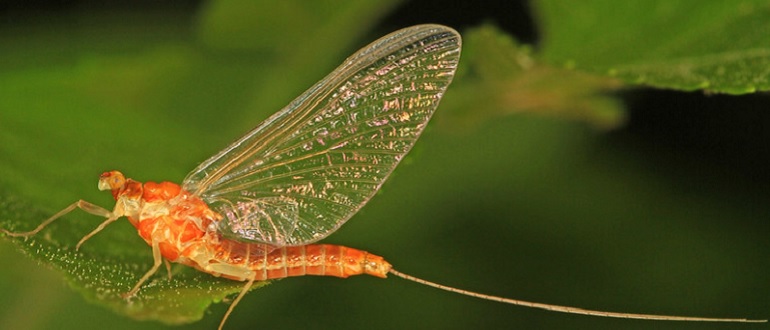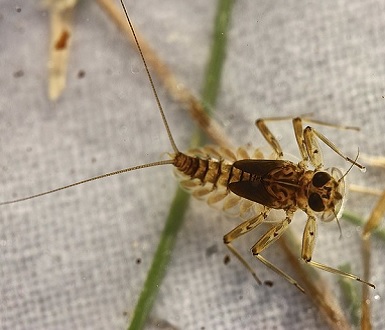Dance of the Mayfly
GET TO KNOW – The Mayfly
Each spring/summer, mayflies around the world emerge from freshwater rivers, lakes, and ponds. Massive populations of these tiny creatures rise up and take flight together. In vast swarms, they fly toward land where their arrival is celebrated by some and cursed by others.
FUN FACT – While many shoreline residents dread the annual arrival of mayflies, others find reason to celebrate. Towns and villages around the world hold yearly festivals in honor of the mayfly. Locally, Dundee, MI on the River Raisin (near Monroe) holds an annual Mayfly and music festival each June. Unfortunately, it is currently cancelled due to Covid but should return in 2022.
Flights (hatches) of mayflies off large bodies of water (i.e. Lake Erie or the upper Mississippi river) may include 50 to 100 billion individuals in a single swarm. Every significant flight becomes a news-worthy event to be studied, discussed, recorded, and tracked. Of course, the mayfly knows nothing of such attention. Taking flight from the water’s surface, the mayfly gets its moment in the sun and performs a graceful mating dance – an aerial ballet – that is the finale to a brief adult life.
Unfortunately, many people see only the mess created by vast hatches of mayflies. Yet, a closer look reveals the simple beauty of this tiny creature’s emergence and flight. Adult mayflies have a single mission – to find a mate. In pursuit of this goal, the mayfly dances in air. Each mayfly flutters its way up to the sky and gently floats down in a graceful performance where males seek out females.
MAYFLIES IN THE ROUGE
Mayflies are aquatic macroinvertebrates that begin life in freshwater rivers, lakes, and ponds. During their immature aquatic stages (known as nymphs or naiads), they are highly sensitive to poor water conditions and are considered important indicators for evaluating water quality.
According to the MSU Extension office, Michigan is home to 126 species of mayflies. Within these different species, there is some variation in degree of water quality sensitivity. Since the Rouge River is located in a highly developed watershed, the most common mayflies found in the watershed are the somewhat less sensitive flathead mayflies (of the family heptageniidae).
During Spring and Fall Bug Hunts, FOTR records aquatic macroinvertebrates (including mayflies) found in stream bottoms and calculates indices of overall stream health for each site tested. The survey tracks how many of the tested sites have stable, improving, or declining health across the survey periods.
Results from the 2020 fall bug hunt noted that flathead mayflies were found at 27 out of 30 sites, and 2 sites even had populations of the more sensitive pronggill mayflies. While such results sound positive, the unfortunate conclusion of the Fall 2020 Bug Hunt indicates a trend toward declining stream health at sample sites.
HABITAT & LIFECYCLE
There are more than 2,000 species of mayflies around the world, and the vast majority have an adult lifespan of less than two full days. Only females in the Baetidae family (who incubate their fertilized eggs within their body) can survive a week or two after emergence. This family, commonly called small minnow mayflies, is found at more than half of FOTR’s sampling sites.
A female mayfly’s final task is to lay her eggs on the surface of the water. The eggs sink to the bottom and generally hatch within a period of a few days to two weeks. Immature mayfly nymphs live up to two years (depending on species) and experience numerous molts while they crawl about the water’s bottom. They eat algae and bits of plant/animal detritus. In this way, nymphs help maintain water cleanliness for other creatures.
Unlike other aquatic macroinvertebrates, mayfly nymphs develop wings while still underwater. In the last immature stage, the nymph must swim up and break through the water’s surface while weighed down by a useless pair of wet wings. It then floats on the surface to dry its wings before it can take flight.
It is common for all members of a specific mayfly population to emerge and take flight together (within a few hours/days at the most). Since mayfly populations rising off large bodies of water may number a hundred billion, a group hatch is a noteworthy event for both humans and local wildlife. Fish, birds, and other predators flock to the hatch site for a feeding frenzy, and only the sheer magnitude of mayfly numbers allows the species to survive.
Surviving mayflies take flight and head to shore to undergo a final molt. The new adult mayflies have no mouth and no ability to feed. They generally live a few short hours on stored energy, during which time they perform their graceful mating dance in the air. Once mating has occurred, males drop away and expire over land while females make a heroic last flight. Females must reach water and deposit their eggs before they too pass away. For a stunning video close-up of mayfly emergence and flight see the BBC video (3 ½ min.): BBC – Mayflies
TAKE ACTION
Population levels of mayflies rise and fall with annual weather conditions and local pollution. During the middle of the 20th century, excessive water pollution led to a dramatic decline in North American mayflies. In the 1990’s, the mayflies made a comeback, but current research indicates North American mayfly populations are again declining.
In a study published Feb 11, 2020 in the journal PNAS, Phillip Stepanian, et all. used radar images to estimate annual mayfly biomass coming off Lake Erie and the upper Mississippi river. They concluded mayfly populations, from both bodies of water, declined by more than 50% from 2012 to 2019. While estimates of moving populations of such tiny individuals have technical difficulties, the overall finding – of significant population declines – seems reliable.
As sensitive aquatic “bugs,” mayflies are susceptible to various water quality problems including decreased levels of dissolved oxygen. Increases in water temperature, due to global warming, decrease the ability of water to hold dissolved oxygen. Additionally, warmer temperatures (with excessive amounts of fertilizers from storm water run-off) increase algae blooms that release toxins into the water and out-compete aquatic creatures for dissolved oxygen.
FOTR has been monitoring aquatic macroinvertebrates since 1998 through our citizen monitoring program. By extensive monitoring and reporting efforts, FOTR can help state and local governmental agencies, corporations, and individuals make better choices for the health of our watershed.
We encourage residents to attend a bug hunt or stonefly search to learn more about these fascinating insects and see if they are found in the river near them.
Bug Hunts and Stonefly Searches FOTR Species MonitoringMAIN PHOTO CREDIT: Adult flathead mayfly (family: heptageniidae) – Judy Gallagher CC-BY-2.0 – image cropped

